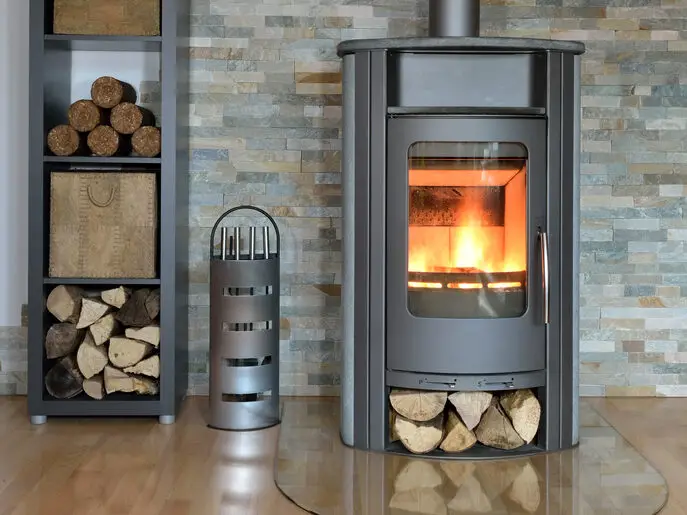Combining a wood-burning stove with underfloor heating is a common query when seeking a smart and efficient way to warm your floor during cold months, typically the underfloor heating system is paired with a heat pump.
Yes, you can combine a wood-burning stove with hydronic underfloor heating. For this, you need to add a thermal store to your back boiler because underfloor heating is a closed vented system. However, underfloor heating is more efficient when it is combined with a heat pump.
Curious to learn more about the compatibility of a wood-burning stove and underfloor heating? Read on to find out the exciting possibilities and considerations!

How would this work?
Underfloor heating operates at 35°C-50°C, which is much lower than the operating temperature of radiators. Many homeowners run their systems at between 23 and 27°C. The temperature of underfloor heating can not be adjusted quickly because the system has a long reaction time. That’s why UFH systems are usually combined with heat pumps.
For this setup to work, you will have to get a water storage tank from which you can run the UFH. A mixing valve can be used to regulate the temperature of the water entering the underfloor.
If you pair your UFH with a wood-burning stove, it’s a good idea to set the system at a temperature lower than you need. And when needed, just increase the temperature. So, ideally you should set the UFH at a low temperature and use the stove as your primary heat source.
Turn the system on several hours before the heat is needed. For better combustion, run the stove for a few hours at a stretch rather than shutting the fire down soon after lighting it up. Frequent starting and shutting down the stove will create more smoke and soot, causing functional issues.
The main challenge with this setup is to maintain a steady temperature of the water running through the underfloor pipework. A wood-burning stove is not ideal for this setup because it generates higher temperature than what is needed for underfloor heating.
To generate the water temperature running through the stove, you can install two separate temperature controllers. One for regulating the temperature of the water that leaves the stove. This water should be around 60°C. Use the other regulator to monitor and maintain the temperature of the water that returns to the stove, making sure this water is around 50 °C.

Advantages and disadvantages of combining a wood-burning stove with underfloor heating
While there are some great advantages of feeding an UFH system with the heat produced by a wood-burning stove, this approach has some challenges. First, let’s take a look at the benefits.
To begin with, a wood-burning stove is a cheap heating source, and newer models are remarkably more efficient than older ones. With a new, sophisticated wood stove, you can optimize the combustion, which means you have some control over the amount of heat the stove produces. A stove with this feature is more compatible with underfloor heating.
Next, using a wood-burning stove to run underfloor heating is more environmentally friendly than most of us tend to think. Firewood is carbon-neutral and not nearly as bad for the environment as fossil fuels.
A wood-burning stove provides immediate heat while underfloor heating maintains a constant temperature. Thanks to this combination, you have some flexibility when the weather changes. If the temperature suddenly drops, you can use your wood stove to quickly raise the temperature. And you can switch off the system as the temperature rises.
The drawback of the setup is that it is hard to constantly run a wood-burning stove with a back boiler. And unless you use the right thermal storage and mixing valve, the temperature of the underfloor heating may be too erratic.
Here are the benefits and challenges at a glance:
| Advantages | Disadvantages |
| Wood is a cheap fuelMore environmentally friendly than fossil fuelsThis setup works well when you need to raise the temperature of the underfloor heating quickly | It’s hard to keep a wood-burning stove all the timeLess control over the temperature of the UFHUsing a wood stove requires a lot of work. You have to cut, stack and haul the wood |
What extra equipment would be required?
In order to make the setup functional, you have to install a water storage tank that receives heat from the wood-burning stove. The water should run from the tank into the underfloor heating. To regulate the temperature of the water running through the underfloor, you need to add a mixing valve.
A thermal store is required because without it the temperature of the water is likely to be too erratic. The thermal store will eliminate the need for keeping the stove on all the time. It will also prevent the UFH from going too hot to too cold the whole time. It will also prevent the formation of air bubbles.
Can you have a wood burning stove on top of underfloor heating?
Yes, you can place a wood-burning stove on top of your underfloor heating. But do not place any flat-bottomed appliance or furniture on top of underfloor heating. There are two problems with this practice.
First, insufficient air circulation will cause hot spots that can damage the floor or the underfloor heating system itself. And second, placing a stove on top of your underfloor heating means wasting some heat. So, plan ahead and exclude the spot where the wood stove is located.
As a rule of thumb, any item with a thermal overall grade (TOG) of 2.5 should not be placed on top of underfloor heating. Most free-standing furniture with a ground clearance of 2-3 inches do not cause hot spots.
More thoughts on combining a wood-burning stove with underfloor heating
Once underfloor heating has been installed, warm water continuously runs through the pipework, and thus provides a gentle, even heat.
One remarkable difference between underfloor heating and radiators is that the former is not designed to be turned on and off too frequently. Time and temperature controls are used to keep the temperature of each room at a desired level. The system reaches its desired temperature slowly, in a controlled way.
Underfloor heating is typically combined with a ground source or air source heat pump. If your wood-burning stove has a back boiler, you can combine it with your UFH. Combining the system with an appropriate heat source is important.
Conclusion
Combining a wood-burning stove with underfloor heating is a bit tricky. The setup is possible not only in theory but also in practice, but you have to be a bit strategic with the approach.
If your wood stove has a back boiler, do not directly connect it to your underfloor heating, because it is not an open vented system. Connect the back boiler to a thermal store first, and then feed the UFH from the thermal store.
We have explained the possibilities and challenges, and hopefully now you are better prepared to take actionable steps. An experienced heating engineer can assess your property and help you find the best heating solution for you.


